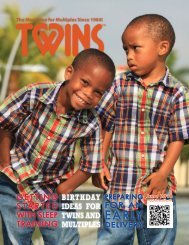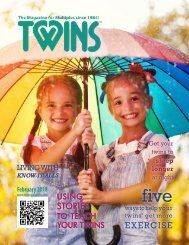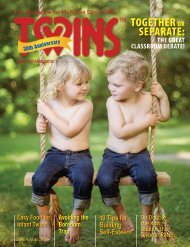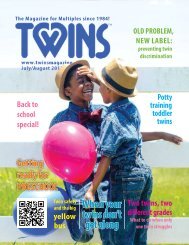2004 Guide To The First Year with Twins
In this edition: Are they twins Back to Sleep Breast feeding Your Twins Does zygosity matter Early Arrivals Getting out and about Getting Started a Basic Layette HELP! I Need Somebody Introducing Solid Foods It's Child's Play Juggling Act…one Mom's story Nicu Primer Protecting Your Child From RSV Pumping Primer SLEEPING Through the NIGHT Teething Times two The best-laid plans The early days The Road to Independece The Twin Bond Weaning Awareness Welcome Home What About Me
In this edition:
Are they twins
Back to Sleep
Breast feeding Your Twins
Does zygosity matter
Early Arrivals
Getting out and about
Getting Started a Basic Layette
HELP! I Need Somebody
Introducing Solid Foods
It's Child's Play
Juggling Act…one Mom's story
Nicu Primer
Protecting Your Child From RSV
Pumping Primer
SLEEPING Through the NIGHT
Teething Times two
The best-laid plans
The early days
The Road to Independece
The Twin Bond
Weaning Awareness
Welcome Home
What About Me
Create successful ePaper yourself
Turn your PDF publications into a flip-book with our unique Google optimized e-Paper software.
Newborn NOTES
Some theories suggest colic is caused by an immature
digestive or central nervous system. As many as onefourth
of all babies younger than 3 months develop colic
at some point. Crying jags may continue for three hours or
more, and may take place three or four times a week. Don’t lose
hope. Colic is a passing phase. It won’t affect your babies’ longterm
health, either.
Babies who cry because of colic don’t experience any more
pain than those without colic, so don’t worry that your babies
are suffering if they’re colicky. Colicky crying is fairly normal.
Babies are hardwired to cry, and some babies are hardwired to
do colicky crying. Colicky crying usually tapers off after 8
weeks, disappearning by about 6 months of age.
Change your diet. Avoid certain foods if you breastfeed
(dairy, beans, onion, caffeine, cabbage, chocolate) or switch to a
hypoallergenic formula if your babies are bottle-fed.
Waiting periods. Try waiting at least 21/2 hours between
feedings, and limit each feeding to 30 minutes. This might help
calm the system. Feed your babies in a calm, quiet spot. This may
help your twins sleep longer and cry less.
Swaddle your babies. Flailing arms and legs can start a crying
jag. Swaddling works. Wrap your fussy infant in a swaddling blanket
to replicate the sensation of being in the womb—this prevents
a “startle response” that triggers more crying.
The “colic hold.” Hold your baby face down, supporting
him with one arm between his legs. Clasp your hands under his
Coping With Colic
tummy. The pressure of the babies’ own weight puts gentle
pressure on his abdominal area.
Back rubs. Lie on your back with baby on your chest; rub
your baby’s back.
Pacing. Try the old standard: Hold your child and pace the
floor.
Music. Play music or sing. Create “white noise” using a background
noise machine, a vacuum cleaner, or radio static (this
simulates the sound your babies heard while in the uterus).
Change of scene. Go to another part of the house or outdoors
to break the cycle of crying.
Driving. The car’s motion and hum of the engine soothe some
babies.
Swing. Battery-operated swings are great for unhappy babies.
MICHAEL AND MATTHEW, AGE 3 MONTHS
To Pacify… or Not?
The World Health
Organization discourages
the use of
pacifiers, based on the belief that they may
interfere with successful breastfeeding.
North American studies have shown
that pacifier use may indirectly interfere
with continued and exclusive breastfeeding.
In these studies, women who introduced
the pacifier to their babies’ in their
first four weeks of life tended to breastfeed
their babies less frequently and, as a result,
experienced breastfeeding problems related
to infrequent feeding. Any decrease in
breastfeeding duration is thought to be a
consequence of the less frequent feeding.
One of the studies also claimed that a
pacifier is not any more effective in calming
a fussy infant than rocking, holding or
breastfeeding. Therefore, it may be wise to
hold off on offering pacifiers to
your babies in the first month.
And never give a pacifier to a hungry baby
to delay feeding, at any age.
If, after the age of 4 weeks, your babies
need to suck longer than adequate nursing
provides, a pacifier—or their hands or
thumbs—may help.
Be sure to use a pacifier safely. Look for
a one-piece pacifier that has a soft nipple
and a shield at least 1 1⁄4 inches wide that is
made of firm plastic and has air holes.
(Do not use the nipple from a baby bottle
as a pacifier. If the baby sucks hard, the
nipple may pop out of the ring and choke
him or her.)
Never tie a pacifier around your baby’s
neck or hand, or to your child’s crib. The
danger of serious injury or even death is
too great.
THE 4 Ss OF
Stress
Here’s an easy-to-remember
four-step stress buster for
moms of multiples
Smile.
Smile and make your eyes
sparkle.
Slack.
Then, take a deep breath.
As you let it out, let your
jaw hang slack.
Sag.
Let your shoulders sag.
Smooth.
Let your forehead relax
and smooth out.
Repeat.
24 GUIDE TO THE FIRST YEAR To subscribe to TWINS call 1-888-55-TWINS or go to www.TwinsMagazine.com

















